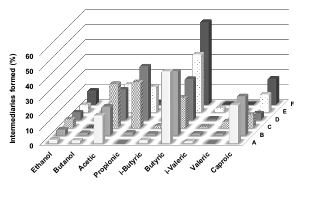 |
|
The cheese industry produces residues, such as acid cheese whey; this by-product has a high organic-matter concentration and other nutrients that are severe environmental contaminants. The aim of this study was to evaluate the acidogenesis/methanogenesis of acid cheese whey with short Hydraulic Retention Times (HRT) in Hybrid-UASB reactors, following the organic matter, ammonia, and orthophosphate evolution. The acidogenic reactor was operated at HRT of 0.5 days, while for the methanogenic reactor, ranged from 1‒2 days; both reactors were operated in series. Results show that the overall HRT of 1.5 days allowed optimal removal (89‒96.8%) with organic loading rates between 2.5 and 10.7 g COD/L-d, while at 14.2‒24.9 g COD/L-d best results were found at 2.5 days of overall HRT. Highest methane productivity ranged from 0.99‒1.15 LCH4/LReactor-d (0.238‒0.308 LCH4/g CODdegraded). Ammonia formation was only significant in methanogenesis (85 mg/L), while orthophosphates showed no change throughout all the process. In conclusion Hybrid-UASB reactors operated at short HRT were suitable for the acidogenesis/methanogenesis of this wastewater. Furthermore, methane can be used for energy generation, and ammonia and orthophosphate might be employed for the development of high value-added products.
Keywords: Acid cheese whey, Acidogenesis/methanogenesis, Hybrid-UASB reactor, industrial effluents, nutrients.
|
|
 |

